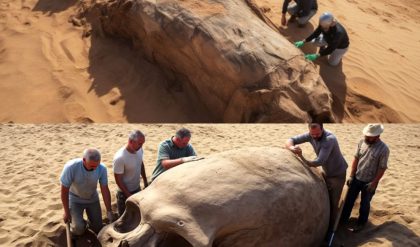In a remarkable archaeological discovery, researchers have unearthed a 6,500-year-old stone artifact in Sri Lanka that promises to unlock secrets of ancient civilizations and their cultures. This mysterious object, intricately carved and adorned with symbols, has baffled scholars and ignited interest in the historical narratives of the region.
The Discovery: A Window into the Past
The artifact was found in a site near the ancient city of Anuradhapura, known for its rich archaeological heritage. Excavations led by a team of Sri Lankan and international archaeologists revealed the stone object, which appears to have been used for ritualistic or ceremonial purposes. Its dimensions and weight suggest that it was significant to the community that crafted it.
Upon initial examination, researchers noted the intricate carvings, which depict various symbols that may represent deities, astronomical phenomena, or significant cultural motifs. The precision of the carvings indicates advanced artistic skills and a deep understanding of symbolic representation in that era.
Cultural Significance: Insights into Ancient Life
This stone artifact provides valuable insights into the social and spiritual practices of ancient Sri Lankans. Experts believe it may have been a ceremonial object used in rituals to honor deities or mark significant life events, such as births, marriages, or harvests. The symbolism engraved on the stone is expected to shed light on the religious beliefs and cosmology of the time.

Archaeologists are also examining the possibility that the artifact served as a form of early writing or record-keeping, suggesting a more sophisticated level of communication and organization within the society. If confirmed, this could redefine our understanding of literacy and documentation in ancient Sri Lanka.
Connections to Other Ancient Civilizations
The discovery of this artifact has sparked comparisons with other ancient cultures across the globe. Scholars are investigating potential connections between the motifs on the stone and similar symbols found in ancient Mesopotamia, Egypt, and the Indus Valley. This could indicate a shared cultural or trade network, or suggest that ideas and beliefs were transmitted across vast distances.
The artifact’s age places it within the Neolithic period, a time marked by significant advancements in agriculture, pottery, and settlement patterns. This context enriches the narrative of human development in Sri Lanka and highlights the island’s role in early civilization.
Future Research and Preservation
The next steps for researchers include detailed analysis using advanced imaging technology to decode the symbols and provide further context about their meaning. Carbon dating and material analysis will also help confirm the artifact’s age and origins.
Preservation of the artifact is crucial, and efforts are underway to ensure that it is safeguarded for future generations. Museums and educational institutions are being consulted to facilitate public access to this important piece of history, allowing visitors to engage with Sri Lanka’s rich heritage.

Conclusion: Unraveling the Past
The unveiling of this 6,500-year-old stone artifact in Sri Lanka represents a significant milestone in our understanding of ancient cultures and their legacies. As researchers delve deeper into the secrets held within the carvings, they not only illuminate the lives of those who came before us but also connect us to the timeless human quest for meaning and understanding.
This discovery serves as a reminder of the importance of archaeology in preserving our collective history and the stories that shape our world. As we continue to explore these ancient riddles, we gain invaluable insights into the richness and complexity of human civilization.





